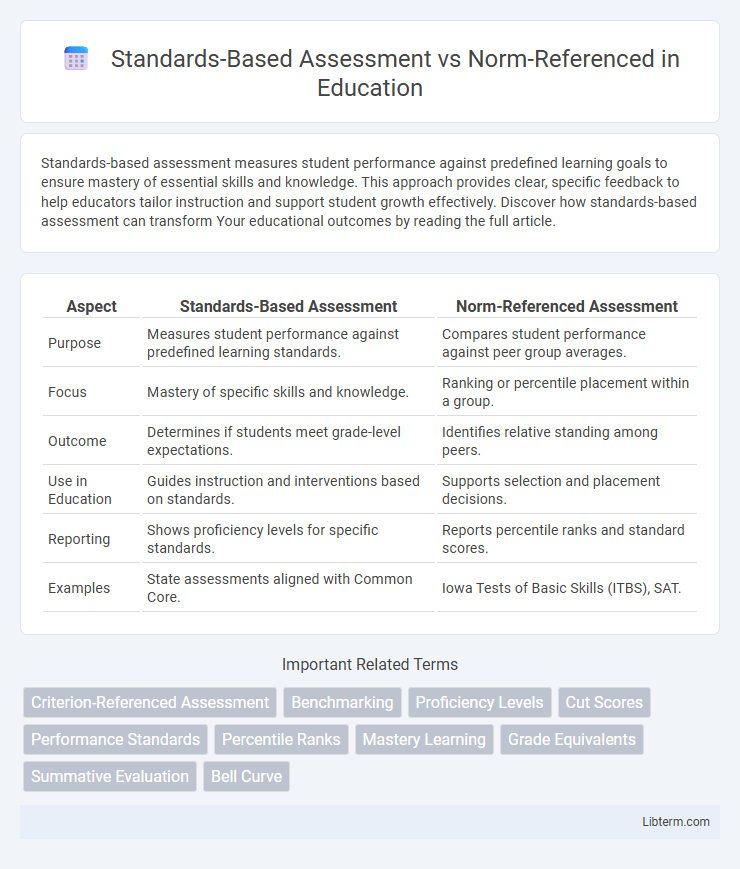Standards-based assessment measures student performance against predefined learning goals to ensure mastery of essential skills and knowledge. This approach provides clear, specific feedback to help educators tailor instruction and support student growth effectively. Discover how standards-based assessment can transform Your educational outcomes by reading the full article.
Table of Comparison
| Aspect | Standards-Based Assessment | Norm-Referenced Assessment |
|---|---|---|
| Purpose | Measures student performance against predefined learning standards. | Compares student performance against peer group averages. |
| Focus | Mastery of specific skills and knowledge. | Ranking or percentile placement within a group. |
| Outcome | Determines if students meet grade-level expectations. | Identifies relative standing among peers. |
| Use in Education | Guides instruction and interventions based on standards. | Supports selection and placement decisions. |
| Reporting | Shows proficiency levels for specific standards. | Reports percentile ranks and standard scores. |
| Examples | State assessments aligned with Common Core. | Iowa Tests of Basic Skills (ITBS), SAT. |
Introduction to Assessment Approaches
Standards-based assessment evaluates student performance against predefined learning objectives, providing specific insights into mastery of academic standards. Norm-referenced assessment compares a student's performance to that of a peer group, ranking individuals on a distribution curve. These assessment approaches serve distinct purposes: standards-based assessments guide instructional decisions aligned with curriculum goals, while norm-referenced tests identify relative standing within a population.
Defining Standards-Based Assessment
Standards-based assessment measures student performance against predefined criteria or learning goals set by educational standards, emphasizing mastery of specific skills and knowledge. It provides detailed feedback on individual progress, helping educators tailor instruction to meet students' needs. Unlike norm-referenced tests, which rank students, standards-based assessments focus on what students know and can do relative to established benchmarks.
Understanding Norm-Referenced Assessment
Norm-referenced assessment compares a student's performance against a statistically average group, providing a percentile ranking that indicates how the student ranks relative to peers. These assessments are valuable for identifying relative strengths and weaknesses by positioning individual scores within a broad population distribution. Understanding norm-referenced assessments helps educators and policymakers make decisions based on comparative data rather than mastery of specific content standards.
Key Differences Between the Two Methods
Standards-based assessment measures student performance against predefined learning standards, emphasizing mastery of specific skills and knowledge, whereas norm-referenced assessment compares a student's performance to that of a peer group, ranking individuals based on relative achievement. Standards-based assessments provide detailed feedback on areas of strength and weakness aligned with curriculum goals, while norm-referenced tests offer a percentile ranking to indicate how a student performs compared to others. The key difference lies in the measurement focus: absolute mastery versus relative positioning within a population.
Advantages of Standards-Based Assessment
Standards-based assessment provides precise measurement of student proficiency against clear, predefined learning objectives, enabling targeted instruction and personalized feedback. It promotes equity by evaluating all students based on consistent criteria rather than relative performance, supporting mastery of essential skills and knowledge. Enhanced transparency in standards-based reporting helps educators, students, and parents understand specific strengths and areas for improvement, fostering continuous academic growth.
Benefits of Norm-Referenced Assessment
Norm-referenced assessments provide clear comparative data by ranking students against a defined population, enabling educators to identify individual performance levels and pinpoint relative strengths and weaknesses. They support large-scale educational decision-making, such as placement, selection, and identifying achievement gaps, by offering standardized benchmarks. This assessment type facilitates targeted interventions based on percentile ranks, helping tailor instruction to meet diverse learner needs effectively.
Challenges Associated with Each Approach
Standards-based assessment faces challenges in ensuring consistency and fairness across diverse educational contexts, often requiring extensive teacher training and clear performance criteria to accurately measure student mastery of predefined learning standards. Norm-referenced assessment struggles with limitations in identifying individual learning needs since it ranks students relative to peers, potentially overlooking mastery in specific content areas and contributing to competitive rather than formative learning environments. Both approaches contend with balancing reliability, validity, and the practical implications of their results for instruction and accountability in educational settings.
Impact on Student Learning and Motivation
Standards-based assessment emphasizes mastery of specific learning goals, promoting student motivation by providing clear expectations and targeted feedback that foster self-improvement. In contrast, norm-referenced assessment ranks students against peers, which may undermine motivation by highlighting relative performance rather than individual growth. Research indicates that standards-based approaches enhance learning outcomes through personalized support and increased student engagement.
Choosing the Right Assessment for Educational Goals
Standards-based assessment measures student performance against predefined learning objectives, providing detailed insights into mastery of specific skills and content, which aligns closely with curriculum standards and instructional goals. Norm-referenced assessment compares a student's performance to a peer group, offering percentile rankings that help identify relative standing but may not reflect individual learning progress or mastery. Selecting the right assessment depends on educational goals: use standards-based assessments to guide instruction and ensure competency in targeted areas, while norm-referenced assessments are effective for identifying giftedness or placement decisions based on comparative achievement data.
Future Trends in Educational Assessment
Standards-based assessment prioritizes measuring student performance against predefined learning objectives, promoting personalized learning pathways and competency mastery. Norm-referenced assessment compares student outcomes to a peer group, often influencing college admissions and competitive environments. Future trends emphasize integrating technology-enhanced, adaptive assessments with data analytics to provide real-time feedback, supporting both standards-based frameworks and norm-referenced comparisons for a comprehensive evaluation of student growth.
Standards-Based Assessment Infographic

 libterm.com
libterm.com